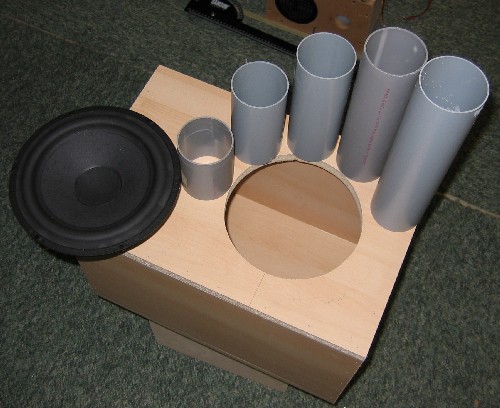I have a pair of original NHT Superzeros and I'm building a single bass bin to accompany them for a more full range music only setup. I say bass bin and not subwoofer because the Superzeros have little to no real bass (see http://www.stereophile.com/content/n...r-measurements), so the bass bin will play up to just a little over 100 hz. For this reason I'm looking at using the Dayton Audio SPA250 plate amp because it's low pass filter is 24db/octave, thinking that the steeper slope will help with the increasing directionality (i.e., localization) of higher bass frequencies. Living in an apartment, economy of space is a high priority. It occurred to me to build a bass bin that would go under my old, large RCA console tv, exactly matiching the footprint of the oak swivel base. This necessitates a shielded woofer, which, as you may know, are now virtually unavailable. Thankfully Parts Express is again stocking the Dayton Audio RS180S-8, a 7" shielded woofer, which seems to meet my needs very well. I'll use two in parallel in a 65 liter box tuned to 29-32 hz with a 3" i.d. port (of appropriate length) for an extended bass shelf (EBS) alignment. With the two woofers sitting right next to the floor, I'm anticipating some room gain/boundary reinforcement will compliment the slight downward slope of the EBS alignment.
Now to my question, or my request for your advice. Considering a range of approx 30 to 110 hz with a 24db/octave low pass filter and a bass reflex box with sufficient bracing and wall thickness to limit wall vibrations (also, the two largest panels will be "sandwiched" between a carpeted floor and the base of the tv), what, if any, acoustic lining do you recommend for the interior walls. Internet information regarding acoustic lining for bass reflex enclosures limited to bass frequencies (e.g. subwoofers) varies considerably and is contradictory. For example: don't use any acoustic lining that could interfere with the desired resonance(s) of a bass reflex alignment, line half of the interior walls including the back with a layer of fiberglass, line with open cell foam, line with closed cell foam, line with egg-crate foam, don't treat the walls at all but instead situate some fiberglass/polyfill in the interior of the enclosure directly behind the woofer(s), etc., etc. I don't need to make the enclosure "act" like a bigger box -- a reason for sometimes using stuffing -- as I'll be able to comfortably get the 65 liters I need. I simply want the box to work per the design and for the bass to be clean. So... what's your advice?
Thanks in advance for any knowledgeable help offered.
David
Now to my question, or my request for your advice. Considering a range of approx 30 to 110 hz with a 24db/octave low pass filter and a bass reflex box with sufficient bracing and wall thickness to limit wall vibrations (also, the two largest panels will be "sandwiched" between a carpeted floor and the base of the tv), what, if any, acoustic lining do you recommend for the interior walls. Internet information regarding acoustic lining for bass reflex enclosures limited to bass frequencies (e.g. subwoofers) varies considerably and is contradictory. For example: don't use any acoustic lining that could interfere with the desired resonance(s) of a bass reflex alignment, line half of the interior walls including the back with a layer of fiberglass, line with open cell foam, line with closed cell foam, line with egg-crate foam, don't treat the walls at all but instead situate some fiberglass/polyfill in the interior of the enclosure directly behind the woofer(s), etc., etc. I don't need to make the enclosure "act" like a bigger box -- a reason for sometimes using stuffing -- as I'll be able to comfortably get the 65 liters I need. I simply want the box to work per the design and for the bass to be clean. So... what's your advice?
Thanks in advance for any knowledgeable help offered.
David






Comment